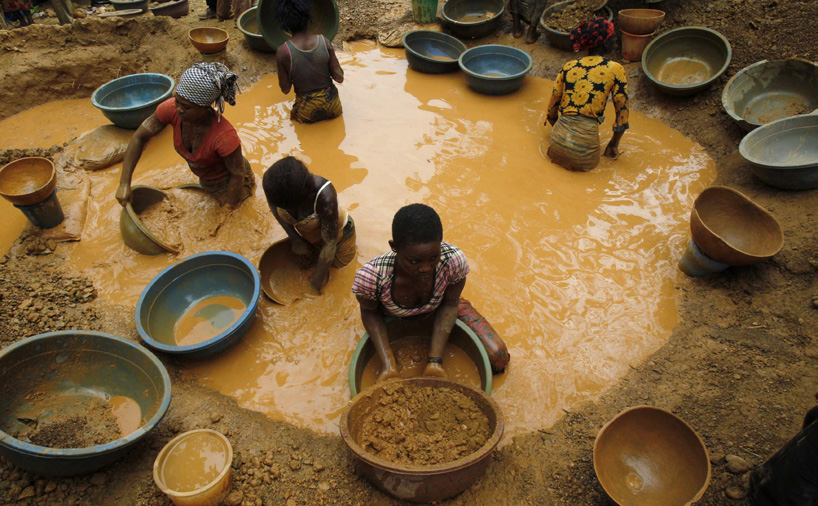Gold is a precious mineral commonly used in making coins, jewellery, electronic devices and in art. As valuable and shiny as it may appear, this mineral has a dark side. Artisanal or small scale gold miners put their lives at risk when extracting gold using toxic chemicals especially mercury. These chemicals pose a danger to the environment and the health of surrounding communities. In gold mining, mercury is a chemical used to recover minute fragments of the mineral that is mixed in soil and sediments. The gold and mercury settle and combine together to create amalgam. Gold is then extracted by evaporating the mercury. The process of extracting gold in artisanal mining uses rudimentary technology, which requires physically demanding and dangerous labour that is why it is male dominated.
In Zimbabwe the percentage of women working in gold mines is however increasing progressively. The visibility is being noticed as gender and women are gradually referenced in mining reform initiatives. In addition of being solely in charge for the home based chores, women have joined the gold rash where they are involved in activities such as crushing ore, collecting water as well as ore concentration. Like in any other developing countries women in Zimbabwe don’t enjoy the same opportunities in terms of access to, control as well as benefits from the small scale mining activities. Apart from that they are not involved in making decisions when it comes to mining plans. Women participating in mining activities are mainly involved in traditional sluice washing for which they are not well paid. Rather they are remunerated with the unwanted tailings washing which they vend or re-process to extract the residual gold using mercury amalgamation. Harsh economic circumstances in Zimbabwe have forced women to begin to step down from supportive roles and take a more prominent and direct role in gold mining which has been a predominantly male environment. Their visibility in gold mining has been accompanied with gender based violence (GBV) at the workplace.
In developing countries artisanal and small scale mining not only contributes to the Gross Domestic Product (GDP) but also provides a source of income for tens of thousands of people. In Zimbabwe gold mining is considered a key driver to sustainable economic development as it contributes to exports as well as its interlinkages with other sectors of the economy. The Mining Industry contributes about 10% of the GDP and 60% of exports. However, mining this precious mineral comes with a price as it brings environmental and health risks to people. Since most miners are not skilled, underequipped and un-educated, they have little appreciation of the environmental impacts and health effects of mining activities.
Inhaling mercury vapour causes serious harm to the nervous, digestive, and immune system. Those using mercury directly in gold extraction, specifically by burning mercury, are therefore mostly prone to fall victim to its adverse effects. Prolonged exposure to mercury results in mercury poisoning and has potential to damage kidneys, impair hearing and cause eyesight problems. In addition to the adverse effects of mercury in humans, prolonged exposure to mercury vapour causes tremor, erythrism, gingivitis, sleep disorders and periodic contractile movements of legs. In extreme circumstances, this toxic chemical can cause people to become comatose and even cause fatality. Mercury usage in gold mining contaminates water sources and soil for livestock and crops leading to bioaccumulation. This mercury ends up being up taken into the food chain causing biomagnification. People residing close to artisanal mining activities can then gradually accumulate mercury in their bodies, which is particularly toxic for children, pregnant women and the elderly. Human bio-monitoring studies have indicated that early diagnosis of the chronic mercury intoxication is difficult to make because of its slow onset and diffuse symptoms.
According to the United Nations Environment Program (UNEP) artisanal gold mining accounts for the largest percentage of global greenhouse gas emissions with a contribution of about 37%. From 2005 up to 2010, greenhouse gas emissions from small scale mining doubled. Zimbabwe is among the top ten nations utilizing huge quantities of mercury in gold mining with an average of 25 tonnes per year being used.
Impending mercury pollution which is escalating as a worldwide problem requires global action. Mercury can be emitted into the air and travel via water, cross national boundaries and can travel thousands of miles via wind in the earth’s atmosphere. The Minamata Convention on Mercury is an opportunity for nations to jointly address the problems relating to efforts put in place to minimize the use of mercury. Implementing the Minamata Convention will help in minimizing mercury contamination from human activities and take into account the release of mercury into the environment whilst maintaining and increasing gold production.
